Karl Shuker's Blog, page 32
May 31, 2016
GIANT BIRDS FROM THE TOMBS OF THE PHARAOHS
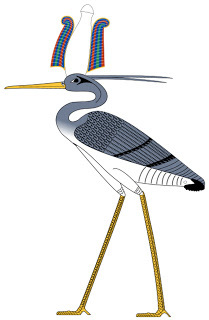 Depiction of the bennu (© Jeff Dahl/Wikipedia
GFDL licence
)
Depiction of the bennu (© Jeff Dahl/Wikipedia
GFDL licence
)The phoenix may be the most famous feathered mystery associated with ancient Egypt - but it is not the only one. Equally mystifying is the bennu bird, which frequently appeared in the Books of the Dead - the hieroglyphic texts that accompanied the deceased in their coffins during the Fifth Dynasty (c.2466-2322 BC) at Heliopolis. Each text was a long roll of papyrus, summarising in picture writing the life of the deceased person alongside whose corpse it had been placed within the coffin. It also offered advice on gaining acceptance for entry into the next world, and revealed that upon acceptance the person would encounter the holy bennu bird, which would bear his or her soul to Ra, the supreme god.
Within the picture text, the bennu is unambiguously depicted as a gigantic heron - taller than a man, with long legs and pointed bill, a slender curved neck, and a pair of very elongate plumes on its head - resembling those of the Eurasian grey heron Ardea cinerea.
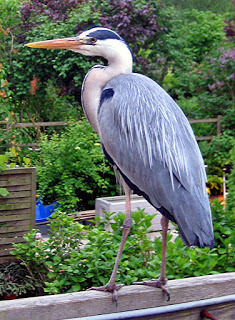 The Eurasian grey heron (public domain)
The Eurasian grey heron (public domain)Archaeologist Dr Ella Hoch, from Copenhagen University's Geological Museum, became curious to discover the inspiration for the noble bennu. Perhaps it had originally been based upon the grey heron (which does exist in Egypt), but had been enlarged in the depictions to emphasise its sacred status and significant role?
Alternatively, it might have been inspired by travellers' reports of the genuinely lofty goliath heron A. goliath, standing up to 5 ft tall, from the Arabian peninsula and sub-Saharan Africa. By far the most compelling possibility, however, had still to be disclosed.
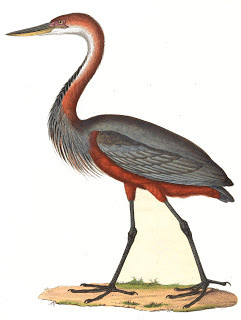 The goliath heron, 1838 painting (public domain)
The goliath heron, 1838 painting (public domain)In 1958, extensive archaeological studies began on the island of Umm an-Nar (aka Umm al-Nar), which lies adjacent to Abu Dhabi of the United Arab Emirates (UAE), in the lagoon complex off the Trucial Coast. Great quantities of animal remains were eventually unearthed, which Hoch documented during the late 1970s in her museum's Contributions to Palaeontology journal. To her surprise but delight, these included some fragments constituting the distal end of the left tibiotarsus (lower leg bone) of an enormous heron - one that was probably even taller than the goliath heron, the world's tallest living species. Indeed, some estimates give its height as having been up to almost 7 ft, i.e. taller than an average human, and with a wingspan approaching 9 ft. Other remains from this newly-revealed colossus were later found, some from separate sites in the Umm an-Nar settlement, and one fragment from Failaka Island, offshore from Kuwait.
The Umm an-Nar material dates from 2,600 BC to 2,000 BC (i.e. the third millennium BC), whereas the Kuwait bone is more recent, from c.1,800 BC, thereby collectively yielding a span of time that wholly encompasses the Fifth Dynasty of Egypt (c.2,494-2,345 BC) - during which period the bennu appeared in Books of the Dead illustrations. The model for the bennu may therefore have been this now-extinct giant heron - a possibility not lost upon Hoch, who christened its species Ardea bennuides.
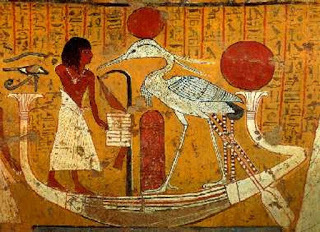 Bennu depicted on ancient Egyptian papyrus (Wikipedia/Public domain)
Bennu depicted on ancient Egyptian papyrus (Wikipedia/Public domain)However, there is also evidence to suggest an even more startling prospect - that this giant heron was still alive as recently as 200 years ago.
In an American Journal of Science report from 1845, its author, a Mr Bonomi, disclosed that between 1821 and 1823 traveller James Burton had chanced upon three enormous conical nests, all within the space of a mile, at a place called Gebel ez Zeit (aka Gebel Zeit), situated on the Red Sea's Egyptian coast, opposite the Mount Sinai peninsula. They had been constructed from all manner of materials, ranging from sticks, weeds, and fish bones to fragments from what had apparently been a very recent shipwreck, and which included a shoe, strands of woollen cloth, a silver watch, and the ribcage of a man - a victim of the shipwreck, whose remaining bones and tattered clothing were spotted by Burton a little further along the coast.
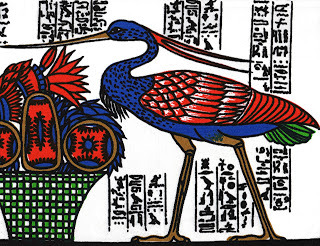 Modern-day, multicoloured depiction of the bennu on a tablecloth purchased by me in Cairo, Egypt, in 2006 (© Dr Karl Shuker)
Modern-day, multicoloured depiction of the bennu on a tablecloth purchased by me in Cairo, Egypt, in 2006 (© Dr Karl Shuker)The nests were colossal in size, with an estimated height (and also a basal diameter) of about 15 ft, and an apical diameter of 2.5-3 ft.
Understandably, Burton was thoroughly bemused concerning their origin - until he began to question the local Arabs. They stated that the nests were those of a huge type of stork-like bird that had deserted the area not long before his arrival there.
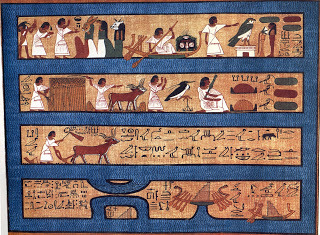 Facsimile of a vignette from the Egyptian Book of the Dead of Ani – the bennu is pictured midway along the second row of depictions (public domain)
Facsimile of a vignette from the Egyptian Book of the Dead of Ani – the bennu is pictured midway along the second row of depictions (public domain)No such bird is known here today; but as his curiosity had been aroused by this episode, Bonomi undertook some investigations of his own, and uncovered persuasive, independent evidence in support of the Arabs' claim.
Delving through the documents of early writers describing Egypt in the far-off days of the pharaohs, he came upon the description of a giant stork once native to the Nile Delta region, and which, in the form of a painted bas-relief, is sculptured upon the wall within the tomb of an officer belonging to the household of Pharaoh Cheops (also called Khufu or Shufu), from the Fourth Dynasty.
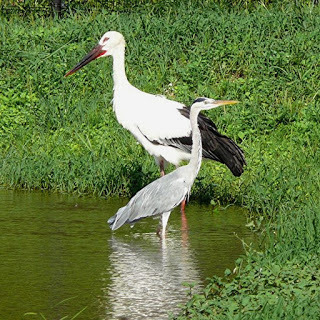 Grey heron and Oriental white stork, showing the principal morphological differences between typical heron and typical stork (© Cory/Wikipedia
CC BY2.1 jp
)
Grey heron and Oriental white stork, showing the principal morphological differences between typical heron and typical stork (© Cory/Wikipedia
CC BY2.1 jp
)According to these sources, it was a bird of gregarious habits, with white plumage, long tail feathers, and a long straight bill; the male additionally bore a tuft on the back of its head, and another upon its breast. However, these features all more readily recall a heron, an egret or even certain cranes rather than a stork, and they compare well with representations of the bennu. Is it plausible, therefore, that this 'stork' was actually Ardea bennuides?
Whatever its taxonomic identity, however, at the time of Pharaoh Cheops (c.2,600 BC) it still survived in the vicinity of the Delta, because specimens were occasionally trapped by the region's peasantry. The nests spied by Burton were probably the product of several generations of these birds (thereby explaining their immense size) rather than just a single pair - and their most recent contributors may have been this species' last representatives.
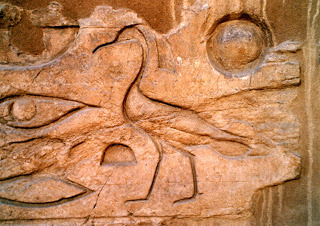 Heron/bennu hieroglyph in temple of Luxor, Egypt (© Dr Karl Shuker)
Heron/bennu hieroglyph in temple of Luxor, Egypt (© Dr Karl Shuker)How tragic, and how ironic, if the bennu, the bird that bore the souls of humans to Heaven, ultimately met its own death at the hand of humans.
This ShukerNature blog post is excerpted from my forthcoming book Still In Search Of Prehistoric Survivors .
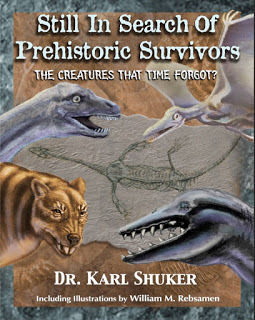
Published on May 31, 2016 04:10
May 10, 2016
A FROG AS BIG AS A GOAT - THE MOST MYSTIFYING LOCH NESS MONSTER SIGHTING EVER?
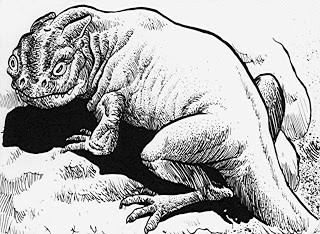 Might the bizarre-sounding cryptid allegedly encountered by diver Duncan Macdonald while underwater in Loch Ness during the late 19th Century have looked something like this? (© Richard Svensson)
Might the bizarre-sounding cryptid allegedly encountered by diver Duncan Macdonald while underwater in Loch Ness during the late 19th Century have looked something like this? (© Richard Svensson)Of all of the many Nessie-related subjects documented by me down through the years (and now collected together in my forthcoming book Here's Nessie: A Monstrous Compendium From Loch Ness ), few have attracted so many enquiries from readers and correspondents as the extraordinary 'frog as big as a goat' supposedly sighted one day by diver Duncan Macdonald while underwater in Loch Ness during the late 1800s (click here for an earlier mention of this cryptid by me on ShukerNature). The incident was first reported almost half a century later, in Inverness's Northern Chronicle newspaper (by an unnamed writer) on 31 January 1934, and this report has in turn been referred to by a number of subsequent publications, but (as far as I am aware) it has never been republished anywhere in full – until now!
Courtesy of the indefatigable research skills of fellow cryptozoological investigator Richard Muirhead (thanks Richard!), earlier today I was delighted to receive a copy of the original Northern Chronicle article, which actually consisted of several different Nessie-themed items linked together. Here is the quite short but very intriguing one concerning Macdonald's alleged encounter:
A DIVER'S EXPERIENCE
Many stories have been circulated by those who go down to the depths inside a diving-bell. Some of them are, doubtless, true; others, of course, must be taken with the proverbial grain of salt. But the truth of any story can very often be guaranteed by a little careful investigation.
Here is such a story, and, as it concerns Loch Ness, and the experience which befell a well-known diver, it might, by reason of its uniqueness, act as a spur to those whose training has fitted them to probe the mysteries of marine zoology, for, in the opinion of the writer, it is but another aspect of the case of the Loch Ness "monster."
Some forty-five to fifty years ago a small sailing vessel carrying a cargo of guano, when making the passage through Loch Ness, struck a submerged reef known as "Johnnie's Point," and sank, fortunately without loss of life.
The mishap occurred during the night, and when dawn broke it was seen that the tops of the masts were still above water.
Realising that the vessel might be raised, a squad of men was quickly on the scene, and chains were passed underneath the hulk.
But ere the job was completed the action of the water suddenly dislodged the craft, and she vanished into the depths.
Still hoping to salve the wreck, the owner secured the services of Mr Duncan Macdonald, a noted diving expert, who was at the time employed at the Crinan Canal.
Mr Macdonald duly arrived, and it was from the Caledonian Canal Company's diving-barge that he carried out operations.
A STRANGE CREATURE
After having made a descent of thirty feet, Mr Macdonald signalled that he wished to come up, and, on being questioned as to whether there was any sign of the ship, he said there was none.
From this it was obvious that further attempts would be useless, so he was undressed, and the party prepared to make for Fort-Augustus, their headquarters.
Now one man in the party, having heard stories of a strange creature which was said to live in the loch, began to question the diver. The latter, however, was at first rather diffident about taking any part in the conversation.
Yet, since the others knew that anything he might tell them would be perfectly true, they persisted, and finally the diver said that he saw a strange creature that day.
It lay, he said, on a ledge of rock, on the self-same ledge, apparently, on which the keel of the wrecked vessel had rested, about thirty feet down.
There, he continued, lay a queer-looking beast, which he described as something in the nature of a huge frog.
It stared at him, but, as it showed neither ferocity nor fear, he did not disturb it. In his own words he "saw that the beast made no effort to interfere with me, and I did not interfere with it." As to size, the diver said the creature was "as big as a goat, or a good wedder [Scots dialect word for a castrated male sheep]."
The story, exactly as given, was told by Mr Donald Fraser, lock-keeper, Fort Augustus, who often heard the diver (his own grand-uncle) tell it many years ago.
STRANGE CREATURES
Naturally, this incident raises some very important questions, and the first is – Is the frog-like creature related in any way to the "monster" or "monsters" which inhabit Loch Ness?
Or does the diver's story show that such creatures are entirely different from the present "monster"?
If this be so, it is not unreasonable to presume that they might prove to be the form, or perhaps one of the forms[,] of life with which – who can tell? – Loch Ness abounds, and on which the "monster" sustains itself.
In any case[,] past reports of strange creatures having been seen in the loch show conclusively that they and their kind have had their homes there for centuries, and, this being so, it would seem that were they living on fish life, i.e., salmon and trout, to the extent that some people think they do, the whole or at least most of the salmon kind – still fairly plentiful – would long since have been decimated.
Thus, there being no reason at all why the above statements should be doubted, it will surely be granted that the time is ripe for some competent body to conduct an investigation into the under-water life of Loch Ness.
This remarkable report does indeed raise some very important questions, though not necessarily the ones posed in it by its anonymous author.
First and foremost: as Loch Ness is famous for the blackness of its waters due to their high concentration of peat, how could Macdonald have perceived this goat-sized 'frog' – or indeed anything else, for that matter – while diving at a depth of 30 ft? Having said that, the very fact that he went down there at all, in search of the sunken guano vessel, suggests that some degree of underwater vision must be possible at such depths in this loch. Perhaps, however, the viewing conditions were not sufficient for him to obtain a clear picture of the creature's form, so, who knows, maybe it wasn't genuinely frog-like after all, but actually was simply a typical Nessie longneck viewed at an angle at which its neck was not visible to him.
Alternatively, there is even the possibility that in reality it was some very large form of vaguely frog-like fish – an extremely big wels catfish Siluris glanis, perhaps, whose wide mouth would certainly call to mind that of a frog if encountered face-on in poor visibility. The wels is not native to Britain, it was introduced to various lakes here from Germany during the 1870s and 1880s, but Loch Ness is not one of the lakes featured in documented introductions. Of course, as so many illegal introductions/releases of non-native species across Britain during the past two centuries readily testify, however, just because no documented introductions of wels specimens into Loch Ness are on record, this doesn't necessarily mean that none has taken place...
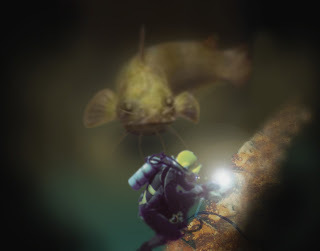 Is this what Macdonald really saw? (© William M. Rebsamen)
Is this what Macdonald really saw? (© William M. Rebsamen)Moving on, it is well worth noting that the Northern Chronicle's telling of this incident is very matter-of-fact, in stark contrast to modern-day retellings, which generally claim that Macdonald was terror-stricken, refused to speak about his sighting for days afterwards, etc, etc. Consequently, these would appear to be melodramatic embellishments added subsequently by person(s) unknown.
The notion aired by the above report's author that perhaps this creature was not itself Nessie but was instead some second, entirely different species of monster – and one, moreover, that may actually constitute the prey of the 'real' Nessie – offers a fascinating if implausible prospect to say the least, doubling the quandary of whether anytype of large cryptid inhabits this vast expanse of freshwater.
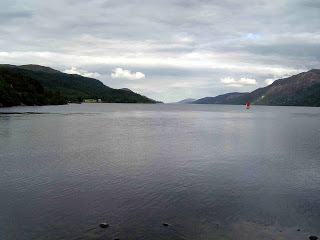 Loch Nessis BIG!! (public domain)
Loch Nessis BIG!! (public domain)Equally thought-provoking is the author's claim that "...past reports of strange creatures having been seen in the loch show conclusively that they and their kind have had their homes there for centuries". On the contrary, because cryptozoological sceptics in particular habitually discount traditional stories of water-horses and water-bulls existing here, for instance, as nothing more than folk-tales, with no factual basis.
Moreover, in a very extensive Fortean Studies paper published in 2001 that surveyed no fewer than 87 cases of mysterious beasts allegedly spied in or on the shores of Loch Ness prior to 1933 (the year that marked the beginning the modern age of Nessie sightings), German cryptozoological investigator Ulrich Magin dismissed all of them as featuring mere legends, unsubstantiated rumours, or creatures that were unrelated to the long-necked Nessie-type cryptids reported from this loch from 1933 onwards. He concluded that there was no pre-1930s tradition of monsters inhabiting Loch Ness, only the possibility that some marine creature had somehow entered it during the early 1930s and that this is what had given rise to subsequent sightings of monsters there. This prospect is one that had been contemplated by the likes of early LNM chroniclers Lieutenant Commander Rupert T. Gould and Dr Anthonie C. Oudemans too.
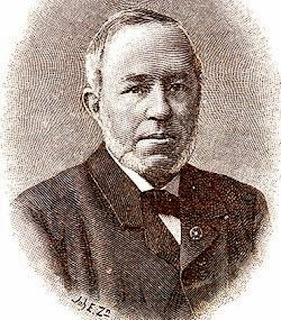 An engraving of Dr Anthonie C. Oudemans (public domain)
An engraving of Dr Anthonie C. Oudemans (public domain)But what did Magin think about Macdonald's 'giant frog'? In his listing, this was Case #32, but, interestingly, he was apparently unaware of its original Northern Chronicle source, because he stated: "This is a story which appears in most books about Nessie but always without reference", and he cited one such book, Peter Costello's In Search of Lake Monsters (1974), as the source that he had consulted.
After quoting Costello's brief version of Macdonald's own description of this underwater mystery beast's appearance, Magin concluded "...the description is unlikely to refer to a long-necked animal or any other animal known in the loch". Or indeed elsewhere, in fact, as I am certainly not aware of any living species of frog-like creature the size of a goat that is currently known to science in the living state (there are of course various extremely large amphibians known from the fossil record).
At present, therefore, the goat-sized 'frog' of Loch Ness remains a major enigma in the Nessie chronicles. Nevertheless, now that its original published source has been resurrected and reproduced here, one of the most mystifying and paradoxical LNM-associated reports – ostensibly unlikely, yet supplied by a very experienced and seemingly highly-reliable eyewitness - is finally readily available for scrutiny and further investigation by future Nessie researchers.
This ShukerNature blog article is excerpted exclusively from my forthcoming book Here's Nessie: A Monstrous Compendium From Loch Ness .
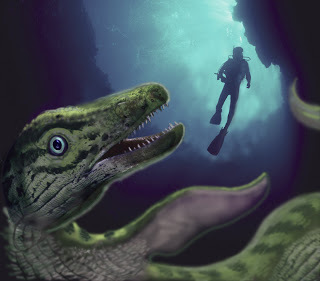 You never know what you may encounter when diving underwater in Loch Ness! (© William M. Rebsamen)
You never know what you may encounter when diving underwater in Loch Ness! (© William M. Rebsamen)
Published on May 10, 2016 13:39
April 16, 2016
A DREAMTIME DROMEDARY? NOT REALLY, BUT STILL A ONE-HUMPED WONDER DOWN UNDER!
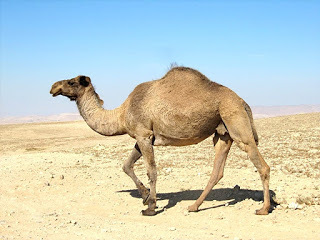 Dromedary in the desert (public domain)
Dromedary in the desert (public domain)Australia is renowned as a land of strange animals, both in the living world and in aboriginal Dreamtime lore. Marsupials, monotremes, monsters, and more, drawn forth from both reverie and reality, have deftly interacted, intermingled, and integrated with one another here for countless millennia to yield an extraordinary menagerie of creatures that is truly unique, and emphatically unlike anything that can be encountered elsewhere in the world.
During the early 1800s, however, reports surfaced Down Under of a creature that was decidedly bizarre even by this island continent's zoological standards, and unquestionably esoteric even in comparison with its native traditions.
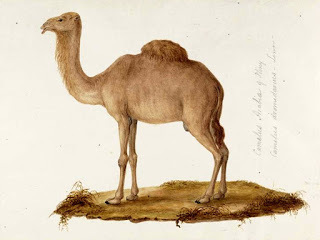 Dromedary, illustration from Drawings of Animals of Greece and the Levant by eminent wildlife artist Ferdinand Bauer (1760-1826) (public domain)
Dromedary, illustration from Drawings of Animals of Greece and the Levant by eminent wildlife artist Ferdinand Bauer (1760-1826) (public domain)The somewhat tragic history of this enigmatic, still-unresolved, yet nowadays long-forgotten entity was recalled in E. Lloyd's A Visit to the Antipodes: With Some Reminiscences of a Sojourn in Australia (1846) as follows:
I have to record a tradition that exists among the white people in the north country, with reference to an animal that sometimes appears, much to their alarm. This is no other than a camel. It is said, amongst the other wise things done by the sanguine people that first settled the land, that one gentleman, arguing from the natural dryness of the climate, that it was a country similar to the Zahara [sic], or Great Desert, and required animals of the same powers of endurance to travel over it, resolved upon doing nothing less than importing a camel, from which he anticipated reaping a fortune. However, calamitously, the camel, after its arrival in the colony, got lost, or ran away into the bush, and for a long time afterwards was never heard of. It is however stated, that he appeared to some shepherds, while tending their flocks, and who were not a little surprised, not to say amazed, at the unlooked-for visitation.
The blacks, in terror, fled at his approach, exclaiming, "big one bullocky! big one bullocky!" It is likewise stated, that the forlorn camel, for a long time roamed through the country, like the wandering Jew, seeking society but finding none; sometimes appearing unintentionally and unexpectedly to shepherds and black fellows, and being innocently the cause of great alarm, until at last another outcast left the realms of social intercourse, and cast himself upon his own energies. This was a harmless donkey, one of three which had found their way into this province. Having strayed from his sphere, like a comet, he took an orbit of his own, exceedingly eccentric, until the two forlorn and wandering planets came within the reach of each other's attraction, and were brought into contact, the result of which is, that they now roam the forest together, alike forsaken, and irrevocably lost.
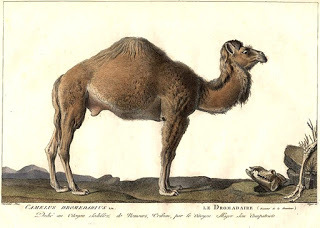 Dromedary - plate by Simon Charles Miger after Nicolas Maréchal (1753-1803), from La Ménagerie du Muséum National d'Histoire Naturelle by Bernard-Germain-Étienne de Lacépède, Georges Cuvier, and Étienne Geoffroy Saint-Hilaire (1804) (public domain)
Dromedary - plate by Simon Charles Miger after Nicolas Maréchal (1753-1803), from La Ménagerie du Muséum National d'Histoire Naturelle by Bernard-Germain-Étienne de Lacépède, Georges Cuvier, and Étienne Geoffroy Saint-Hilaire (1804) (public domain)This sad little episode was no doubt repeated many times thereafter too, with dromedaries Camelus dromedarius imported Down Under for desert exploration ultimately escaping (or being deliberately released), because today there are naturalised herds of these one-humped camels in many parts of Australia, including the Northern Territory, western Queensland, northern South Australia, and (especially) Western Australia. Indeed, by 2005 there were an estimated 500,000 individuals living in the wild amid this vast island continent, and increasing at an annual growth rate of 10 per cent (so if this rate had stayed constant from then until now, by the end of 2015 there would have been around 1 million).
What makes Lloyd's account so noteworthy however, is that according to official records, the first camels imported into Australia (all dromedaries) did not arrive until 1840, and their whereabouts were fully documented until beyond 1846 (the publication date of Lloyd's book). Moreover, the first major importations did not occur until 1860. Yet his account makes clear that the camel reported by Lloyd had been roaming the deserts Down Under long before the 1840s - so who was its original owner, and when exactly had it been imported into Australia?
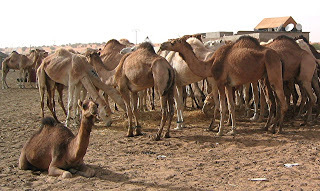 A herd of domesticated dromedaries (public domain)
A herd of domesticated dromedaries (public domain)Unless this entire event is a hoax, or unless there are even earlier records still awaiting disclosure, it would appear that this bewildering 'big one bullocky' was the very first dromedary ever to set hoof in the Antipodes. Hardly surprising, therefore, that it elicited such consternation among its astonished aboriginal observers.
After all, even taking into account the dramatic zoological diversity to be found amid ancient native lore here, a dromedary would still seem a very daunting entity to anyone not previously cognisant of camelids. And so, even though it was not a bona fide dromedary of the Dreamtime, this unexpected itinerant was nonetheless a veritable one-humped wonder Down Under!
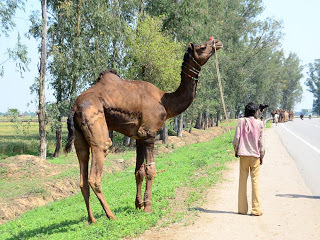 If you'd never seen a dromedary before, this very sizeable and strange-looking beast would certainly be a most daunting creature to encounter in the wild! (public domain)
If you'd never seen a dromedary before, this very sizeable and strange-looking beast would certainly be a most daunting creature to encounter in the wild! (public domain)NB - Although the imported camel's species was not specified in Lloyd's account, his above-quoted comparison of northern Australia's dry climate with that of North Africa's Sahara plus his argument that animals required to traverse the former territory's arid terrain would need to be ones that are capable of surviving in the latter desert readily confirm that it must have been a dromedary. For this species was indeed originally native to the Sahara, and also to the Arabian Desert in the Middle East, before becoming domesticated and transported widely across the globe (with its wild ancestors eventually dying out around 2,000 years ago).
In contrast, the only other modern-day species, the Bactrian or two-humped camel C. bactrianus, is much rarer, and is native only to the steppes of central Asia in the wild state. Moreover, in its domestic form this latter species has only been introduced into Australia much more recently and in much smaller numbers than the dromedary, with only a very few individuals known to be existing in a naturalised state anywhere in Australia
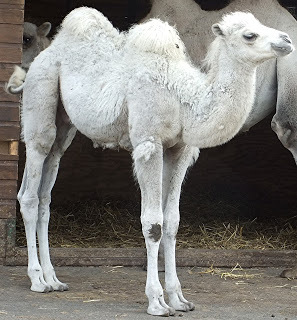 A young white domestic Bactrian camel (© Dr Karl Shuker)
A young white domestic Bactrian camel (© Dr Karl Shuker)This ShukerNature blog article is excerpted and expanded from my book Mysteries of Planet Earth: An Encyclopedia of the Inexplicable .
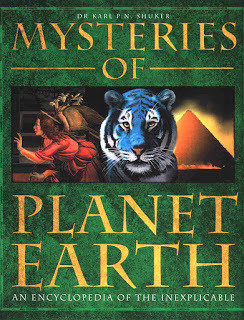
Published on April 16, 2016 12:34
April 15, 2016
AN AMERICAN MYSTERY BLACK PANTHER DEPICTED IN A FAMOUS MODERN-DAY PAINTING
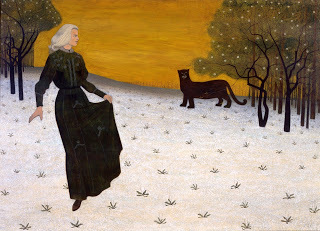 'Story Told By My Mother', painted in 1955 by Carroll Cloar (© Memphis Brooks Museum of Art, Tennessee, USA – reproduced here on a strictly non-commercial Fair Use basis only)
'Story Told By My Mother', painted in 1955 by Carroll Cloar (© Memphis Brooks Museum of Art, Tennessee, USA – reproduced here on a strictly non-commercial Fair Use basis only)In various previous ShukerNature articles, I've documented several fascinating examples of apparent cryptids depicted by famous artists. Now, I am adding yet another such example to this select company.
I am very grateful to American correspondent David McAvoy for bringing to my attention a remarkable painting on display at the Memphis Brooks Museum of Art in Tennessee, USA. Entitled 'Story Told By My Mother', and opening this present ShukerNature article, it was produced in 1955 by highly-acclaimed Arkansas-born artist Carroll Cloar (1913-1993), and depicts a snow scene in which a woman is stepping briskly away from a very large black panther-like cat standing at the edge of some trees.
David informed me that it was inspired by tales that Cloar had heard from his mother concerning so-called black panthers that had once roamed Arkansas. Moreover, David himself hails from Arkansas, and he mentioned that he has heard such stories for as long as he can remember. Indeed, mysterious, unidentified big cats of black panther-like appearance (i.e. resembling melanistic leopards, which are uniformly black in background coat colouration) have been reported all over North America for centuries.
 A black panther (melanistic leopard) (© Dr Karl Shuker)
A black panther (melanistic leopard) (© Dr Karl Shuker)Leopards of course are not native to the New World, so if such beasts are indeed roaming the wilds here, they can only be escapee or released individuals from captivity. However, their eyewitnesses often claim that these cats are not black leopards anyway (nor black jaguars either, although normal spotted jaguars have been confirmed to exist at least in certain southern states such as Arizona and California on a fairly regular basis in earlier times), but are instead black pumas. (Other names for pumas, incidentally, include cougars, mountain lions, catamounts, painters, and - very confusingly - panthers.) Yet no such cat form has ever been scientifically confirmed from North America, only two such specimens have been procured in tropical Latin America, and no captive individuals are currently known to exist anywhere (I have previously documented one possible example exhibited at London Zoo during the 1800s). Moreover, all three of these latter specimens were not uniformly black anyway, but were only black dorsally; ventrally, they were much paler.
In short, even if they do occur, black pumas are exceptionally rare as far as physical evidence for their reality is concerned, and those few confirmed specimens do not match the sightings of large all-black felids in North America. Bearing in mind that countless normal-coloured pumas (i.e. either tawny or grey) have been shot there, however, and also bearing in mind that in view of the numerous reports of black panther-like cats on file from this continent, whatever this cat form may be it does not appear to be especially rare, why are no North America specimens ever forthcoming if it is indeed a melanistic version (morph) of the puma? This apparent paradox remains a major riddle for New World cryptozoology to solve, but at least we do now have an additional and most interesting, unexpected piece of evidence supporting the existence of black panther-like cats in North America, regardless of their formal taxonomic identity.
For a comprehensive examination of the black puma controversy, please click here , and see also my books Mystery Cats of the World and Cats of Magic, Mythology, and Mystery .

Published on April 15, 2016 14:00
AN AMERICAN MYSTERY BLACK CAT DEPICTED IN A FAMOUS MODERN-DAY PAINTING
 'Story Told By My Mother', painted in 1955 by Carroll Cloar (© Memphis Brooks Museum of Art, Tennessee, USA – reproduced here on a strictly non-commercial Fair Use basis only)
'Story Told By My Mother', painted in 1955 by Carroll Cloar (© Memphis Brooks Museum of Art, Tennessee, USA – reproduced here on a strictly non-commercial Fair Use basis only)In various previous ShukerNature articles, I've documented several fascinating examples of apparent cryptids depicted by famous artists. Now, I am adding yet another such example to this select company.
I am very grateful to American correspondent David McAvoy for bringing to my attention a remarkable painting on display at the Memphis Brooks Museum of Art in Tennessee, USA. Entitled 'Story Told By My Mother', and opening this present ShukerNature article, it was produced in 1955 by highly-acclaimed Arkansas-born artist Carroll Cloar (1913-1993), and depicts a snow scene in which a woman is stepping briskly away from a very large black panther-like cat standing at the edge of some trees.
David informed me that it was inspired by tales that Cloar had heard from his mother concerning so-called black panthers that had once roamed Arkansas. Moreover, David himself hails from Arkansas, and he mentioned that he has heard such stories for as long as he can remember. Indeed, mysterious, unidentified big cats of black panther-like appearance (i.e. resembling melanistic leopards, which are uniformly black in background coat colouration) have been reported all over North America for centuries.
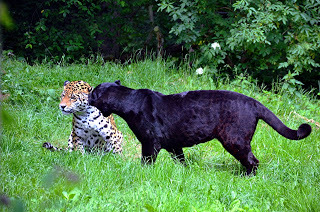 A black (melanistic) leopard with a normal spotted leopard (public domain)
A black (melanistic) leopard with a normal spotted leopard (public domain)Leopards of course are not native to the New World, so if such beasts are indeed roaming the wilds here, they can only be escapee or released individuals from captivity. However, their eyewitnesses often claim that these cats are not black leopards anyway (nor black jaguars either, although normal spotted jaguars have been confirmed to exist at least in certain southern states such as Arizona and California on a fairly regular basis in earlier times), but are instead black pumas. (Other names for pumas, incidentally, include cougars, mountain lions, catamounts, painters, and - very confusingly - panthers.) Yet no such cat form has ever been scientifically confirmed from North America, only two such specimens have been procured in tropical Latin America, and no captive individuals are currently known to exist anywhere (I have previously documented one possible example exhibited at London Zoo during the 1800s). Moreover, all three of these latter specimens were not uniformly black anyway, but were only black dorsally; ventrally, they were much paler.
In short, even if they do occur, black pumas are exceptionally rare as far as physical evidence for their reality is concerned, and those few confirmed specimens do not match the sightings of large all-black felids in North America. Bearing in mind that countless normal-coloured pumas (i.e. either tawny or grey) have been shot there, however, and also bearing in mind that in view of the numerous reports of black panther-like cats on file from this continent, whatever this cat form may be it does not appear to be especially rare, why are no North America specimens ever forthcoming if it is indeed a melanistic version (morph) of the puma? This apparent paradox remains a major riddle for New World cryptozoology to solve, but at least we do now have an additional and most interesting, unexpected piece of evidence supporting the existence of black panther-like cats in North America, regardless of their formal taxonomic identity.
For a comprehensive examination of the black puma controversy, please click here , and see also my books Mystery Cats of the World and Cats of Magic, Mythology, and Mystery .

Published on April 15, 2016 14:00
April 13, 2016
FROM BARGUEST AND BOOBRIE TO BLUE MEN OF THE MINCH - A SHUKERNATURE SELECTION OF ESOTERIC ENTITIES FROM THE BRITISH ISLES
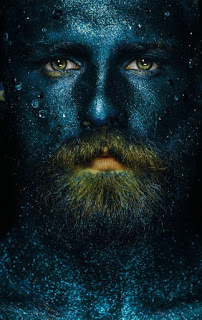 A Blue Man of the Minch (I found this image online some time ago, unsourced and uncredited, but it looks like it may be a modified version – by person(s) unknown – of a picture from highly-acclaimed London-based photographer Chris Parkes's spectacular 'All that Glitter is Green' series; if so, © Chris Parkes, and thus used here on a strictly non-commercial, Fair Use basis only; also, please click
here
to visit Chris Parkes's website and see some of his wonderful photographs)
A Blue Man of the Minch (I found this image online some time ago, unsourced and uncredited, but it looks like it may be a modified version – by person(s) unknown – of a picture from highly-acclaimed London-based photographer Chris Parkes's spectacular 'All that Glitter is Green' series; if so, © Chris Parkes, and thus used here on a strictly non-commercial, Fair Use basis only; also, please click
here
to visit Chris Parkes's website and see some of his wonderful photographs)The British Isles are said to contain more ghosts than anywhere else in the world. Less well-known is that a remarkable diversity of monsters, mythological creatures, and mystery beasts have also been reported from these ancient lands, as will be seen here in this exclusive ShukerNature selection of some notably esoteric entities from my homeland. The trick, however, is trying to decide which category each of them belongs to - fact or fable, legend or reality, the natural world or the supernatural realm - a perilous choice that I will leave, gentle reader, to you!
BAISTE-NA-SCOGHAIGH
It is not widely known that Britain can lay claim to its very own indigenous species of unicorn. Yet according to Hebridean folklore, the lochs on the Inner Hebrides island of Skye are home to just such a creature, called the baiste-na-Scoghaigh (aka biasd na Srogaig). Despite its long legs, however, its bulky, lumbering form renders it more akin to a rhinoceros than to the elegant unicorn of classical legend; and as it can assume human form, this deceptive creature is technically a were-unicorn. See also here for more details.
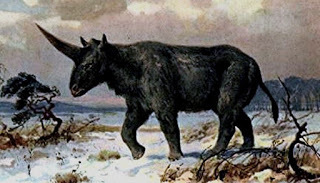 Is this what the baiste-na-Scoghaigh looks like? (public domain)
Is this what the baiste-na-Scoghaigh looks like? (public domain)BARGUESTOne of England's most dreadful bogey-beasts, the barguest is able to assume several different guises, but its most common form is as a huge, shaggy-furred black dog with enormous fiery eyes, and sometimes even a pair of horns. According to tradition, this spectral hound haunts lonely areas of wasteland in Yorkshire, but especially between Wreghorn and Headingley Hill, near Leeds. Its appearance is widely believed to foretell an impending death, usually of some important figure living locally, and is often accompanied by fearful howling, baying, and sometimes the sound of rattling chains.
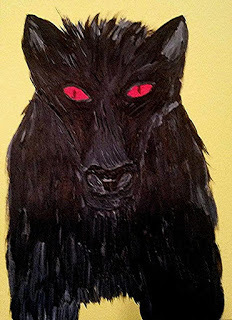 Beware of the barguest! (© Jane Cooper)
Beware of the barguest! (© Jane Cooper)BLUE MEN OF THE MINCHThe Minch is a strait separating the largest Outer Hebridean island, Lewis-and-Harris, from the Scottish mainland. According to local maritime tradition, it is also home to a fierce race of mermen, distinguished from other fish-tailed folk by their vivid blue skin. Happily, however, their fondness for attacking sailors can be readily countered, simply by berating them exclusively in rhyme!
BOOBRIEScottish Highland lore describes the boobrie as a black lake-dwelling bird with white marks upon its neck and breast, resembling the great northern diver Gavia immer but very much bigger, and deadlier. For whereas divers (or loons, as these birds are referred to in North America) are content to feed upon fishes, the boobrie will allegedly seize any sheep or cow that dares venture near this monstrous bird's aquatic abode, and haul it beneath the water, thereafter to feed upon its drowned carcase.
HAIRLESS BLUE HORSEDuring 1868, a very unusual horse was exhibited at London's famous Crystal Palace. Not only was it completely hairless, but its skin was blue, so that it looked as if it had been sculpted from some rare form of oriental blue marble. This singular steed had been captured on the plains of South Africa by a merchant called Lashmar in 1860, and had been associating with a herd of those now-extinct, incompletely-striped zebras known as quaggas. The fate of the hairless blue horse after its Crystal Palace days is unknown - as is its identity. Could it have been a freak quagga, rather than merely a freak domestic horse run wild? See also here for more details.
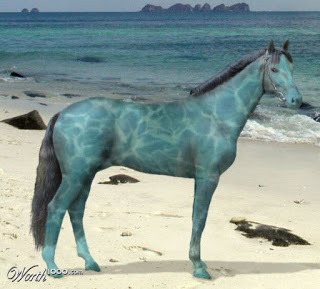 Photoshopped image of a horse resembling the Crystal Palace-exhibited curiosity described here (© Daisiem worth1000 – reproduced here on a strictly non-commercial Fair Use basis only)
Photoshopped image of a horse resembling the Crystal Palace-exhibited curiosity described here (© Daisiem worth1000 – reproduced here on a strictly non-commercial Fair Use basis only)LOUGH DUBH MONSTEROne day in March 1962, schoolteacher Alphonsus Mullaney and his son went fishing to Lough Dubh ('Black Lake') in County Galway, Ireland...and caught a monster instead. Suddenly, their line became taut, and when they attempted to reel in their catch, they saw to their horror that they were hauling up an incredible water beast like nothing ever reported before - or since. The size of a cow, it had short thick legs, small ears, dark grey skin covered in short bristles, and a large hippopotamus-like face - with a sharp rhinoceros-like horn on the end of its snout! Not surprisingly, the two anglers fled away, but when they returned with a posse of local men, the lake's mysterious monster had vanished again. See also here for further details.
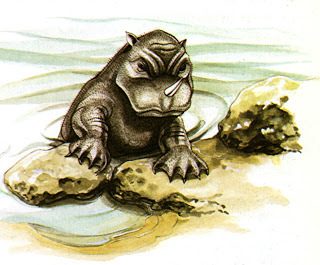 Artistic representation of the Lough Dubh monster (© Orbis Publishing - reproduced here on a strictly non-commercial Fair Use basis only)
Artistic representation of the Lough Dubh monster (© Orbis Publishing - reproduced here on a strictly non-commercial Fair Use basis only)LYMINSTER KNUCKERAn unexpectedly loquacious English dragon, the knucker lived in a deep pool near the church at Lyminster, close to Arundel, in Sussex. Unfortunately, however, it developed a great liking (in the gastronomic sense!) for sheep, pigs, and even the odd farmer or two...until a local youth called Jim Puttock came along. After deliberately over-feeding the knucker with a heavy pudding that gave it severe indigestion, Puttock promised to provide a remedy for curing its stomach ache. The remedy in question, albeit decidedly unorthodox, was also undeniably effective - after engaging it in seemingly innocent conversation, Puttock abruptly wielded his trusty sword and chopped off the knucker's head!
MINIATURE WOLVES OF ACHILL ISLANDAccording to Irish tradition, County Mayo's Achill Island was home to a type of small wolf-like beast long after true wolves had died out elsewhere in the British Isles. They were said to resemble normal wolves in overall appearance except for their relatively small stature. No such creatures have been reported here in recent times, however, so even if they really did once exist they have now presumably died out.
ORKNEY BOAR-WHALEAccording to Swedish archbishop Olaus Magnus (1490-1557), an extraordinary sea monster resembling a hybrid of whale and wild boar was sighted in the sea north of Scotland's Orkney Islands in 1537. In bestiary compiler Conrad Gesner's tome, Nomenclator Aquatilium Animantium...(1560), this Orcadian boar-whale was depicted with the head and body of a boar but with scales instead of fur, flippers instead of feet, and a fish-like tail. Not surprisingly, it has never been identified.
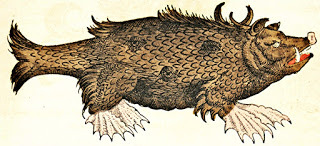 The Orkney boar-whale as depicted in Gesner's tome (public domain)
The Orkney boar-whale as depicted in Gesner's tome (public domain)RENWICK COCKATRICEDuring the demolition of an old church at Renwick in Cumbria, northern England, during 1733, workmen were terrified when a huge winged apparition rose up out of the foundations, for in appearance it closely resembled a cockatrice. According to legend, this was a lethal dragonesque monster combining reptilian scales, leathery bat-like wings, and a snake-like tail with the feathered body and also the wattled, coxcomb-surmounted head of a farmyard rooster, and which was hatched by a toad from a shell-less egg laid by a cockerel! As this hideous creature sallied forth, the Renwick villagers fled in all directions - except for one brave man named John Tallantine. Armed with a lance hewn from the rowan tree, which is famed for its reputed power in warding off evil, Tallantine pursued the cockatrice into the churchyard, and after a fierce battle he succeeded in slaying it. As a reward, the grateful people of Renwick decreed that for ever afterwards Tallantine's descendants would be exempt from paying tithes. A copy of an account describing this alleged occurrence is preserved in Renwick's current church.
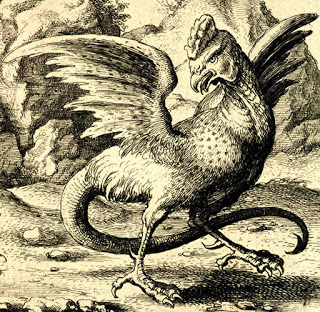 Cockatrice, depicted by Wenceslaus Hollar, 1600s (public domain)
Cockatrice, depicted by Wenceslaus Hollar, 1600s (public domain)ST SEONAN'S MONSTERLike an amphibious cyclops, this maned water monster had a single eye gleaming brightly in the centre of its forehead. It also had a whale's fluked tail, and a mighty chest that sounded like a pair of huge bellows when it exhaled its scorching breath. It frequented the island of Iniscathy (aka Inis Cathaigh), located in Ireland's Shannon Estuary, and whenever it sharpened its razor-sharp iron talons, sparks of fire would dance upon the island's rocky surface. Eventually, however, it was allegedly banished by St Seonan.
SCREAMING WHITE RABBITReputedly, an eerie spectral rabbit, pure white in colour and emitting a hideous screaming cry, has been encountered spasmodically in an area of Cobridge in northern Staffordshire, England, that is known locally as The Grove. It is claimed that this white rabbit is the restless ghost of teenager John Holdcroft, who was strangled to death by fellow teenager Charles Shaw one day in August 1833 after Shaw had accused him of cheating at a game of pitch and toss. Terrified by what he had done, Shaw hung a noose around his friend's neck and tried to pretend that he had committed suicide, but he later confessed to the murder and was sentenced to transportation. As for the rabbit, its eldritch shrieks are supposedly John Holdcroft's death screams.
WINGED FEATHERED SNAKESRemarkably, until as recently as the early 1800s some local inhabitants believed that creatures apparently resembling winged feathered snakes congregated in large numbers within the wooded vales of Penllyne and Penmark in Glamorgan. Extraordinarily beautiful, they had shimmering bodies whose scales sparkled like multicoloured jewels, rainbow-hued crests, and outspread plumed wings. Despite their flamboyant finery, however, Glamorgan's feathered flying snakes were reputedly slaughtered like common vermin by farmers, on account of their taste for the farmers' poultry, until at last they were completely exterminated. See also here for more details.
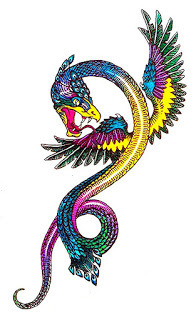 Depiction of one of the winged feathered snakes that appeared on the front cover of the original 1997 American edition of my book
From Flying Toads To Snakes With Wings
(© Dr Karl Shuker/Llewellyn Publications)
Depiction of one of the winged feathered snakes that appeared on the front cover of the original 1997 American edition of my book
From Flying Toads To Snakes With Wings
(© Dr Karl Shuker/Llewellyn Publications)YELPING BEAST OF MANY COLOURSFinally, but staying with extraordinarily beautiful creatures: Loosely connected to the Arthurian corpus of legends and originally composed anonymously in French during the 1300s, Perceforest is a 6-volume prose romance presenting a fictionalised origin of Great Britain. One memorable scene from it features Maronex the Gilded Knight, magnificently bedecked in brilliant golden armour, encountering a huge and equally dazzling, rainbow-hued creature that gave voice to ear-splitting yelping cries when it was pursued by him after it seized a stag in its jaws. Hence it is generally referred to as the Yelping Beast or the Beast of Many Colours. After dropping the deer as it fled headlong through the forest, the Yelping Beast finally reached its lair, a dense thicket in the midst of a deep marsh, and successfully eluded Maronex when his horse became enmired up to its belly in the marsh's black mud. Although Maronex was eventually able to free his horse, he conceded that it would be perilous in the extreme to attempt any further pursuit of the Yelping Beast through such treacherous, potentially lethal terrain, so he reluctantly turned back, his multicoloured quarry far beyond his reach by now. The creature's penchant for exceedingly loud yelping cries, incidentally, readily calls to mind comparable behaviour described for the snake-headed, leopard-bodied, hart-footed Questing Beast in traditional Arthurian legend.
[image error] The Yelping Beast of Many Colours and Maronex the Gilded Knight, from Royal 19 E II mss, Perceforest, Anciennes croniques Dangleterre, faictz et gestes du roy Perceforest, et des chevaliers du Franc Palais, version transcribed by David Aubert in late 1400s, Holland (public domain)
Published on April 13, 2016 15:40
FROM BARGUEST AND BOOBRIE TO BLUE MEN OF THE MINCH - A SHUKERNATURE TOP 12 LISTING OF ESOTERIC ENTITIES FROM THE BRITISH ISLES
 A Blue Man of the Minch (I found this image online some time ago, unsourced and uncredited, but it looks like it may be a modified version – by person(s) unknown – of a picture from highly-acclaimed London-based photographer Chris Parkes's spectacular 'All that Glitter is Green' series; if so, © Chris Parkes, and thus used here on a strictly non-commercial, Fair Use basis only; also, please click
here
to visit Chris Parkes's website and see some of his wonderful photographs)
A Blue Man of the Minch (I found this image online some time ago, unsourced and uncredited, but it looks like it may be a modified version – by person(s) unknown – of a picture from highly-acclaimed London-based photographer Chris Parkes's spectacular 'All that Glitter is Green' series; if so, © Chris Parkes, and thus used here on a strictly non-commercial, Fair Use basis only; also, please click
here
to visit Chris Parkes's website and see some of his wonderful photographs)The British Isles are said to contain more ghosts than anywhere else in the world. Less well-known is that a remarkable diversity of monsters, mythological creatures, and mystery beasts have also been reported from these ancient lands, as will be seen here in this exclusive ShukerNature listing of 12 notably esoteric entities from my homeland. The trick, however, is trying to decide which category each of them belongs to - fact or fable, legend or reality, the natural world or the supernatural realm - a perilous choice that I will leave, gentle reader, to you!
BAISTE-NA-SCOGHAIGH
It is not widely known that Britain can lay claim to its very own indigenous species of unicorn. Yet according to Hebridean folklore, the lochs on the Inner Hebrides island of Skye are home to just such a creature, called the baiste-na-Scoghaigh (aka biasd na Srogaig). Despite its long legs, however, its bulky, lumbering form renders it more akin to a rhinoceros than to the elegant unicorn of classical legend; and as it can assume human form, this deceptive creature is technically a were-unicorn. See also here for more details.
 Is this what the baiste-na-Scoghaigh looks like? (public domain)
Is this what the baiste-na-Scoghaigh looks like? (public domain)BARGUESTOne of England's most dreadful bogey-beasts, the barguest is able to assume several different guises, but its most common form is as a huge, shaggy-furred black dog with enormous fiery eyes, and sometimes even a pair of horns. According to tradition, this spectral hound haunts lonely areas of wasteland in Yorkshire, but especially between Wreghorn and Headingley Hill, near Leeds. Its appearance is widely believed to foretell an impending death, usually of some important figure living locally, and is often accompanied by fearful howling, baying, and sometimes the sound of rattling chains.
 Beware of the barguest! (© Jane Cooper)
Beware of the barguest! (© Jane Cooper)BLUE MEN OF THE MINCHThe Minch is a strait separating the largest Outer Hebridean island, Lewis-and-Harris, from the Scottish mainland. According to local maritime tradition, it is also home to a fierce race of mermen, distinguished from other fish-tailed folk by their vivid blue skin. Happily, however, their fondness for attacking sailors can be readily countered, simply by berating them exclusively in rhyme!
BOOBRIEScottish Highland lore describes the boobrie as a black lake-dwelling bird with white marks upon its neck and breast, resembling the great northern diver Gavia immer but very much bigger, and deadlier. For whereas divers (or loons, as these birds are referred to in North America) are content to feed upon fishes, the boobrie will allegedly seize any sheep or cow that dares venture near this monstrous bird's aquatic abode, and haul it beneath the water, thereafter to feed upon its drowned carcase.
HAIRLESS BLUE HORSEDuring 1868, a very unusual horse was exhibited at London's famous Crystal Palace. Not only was it completely hairless, but its skin was blue, so that it looked as if it had been sculpted from some rare form of oriental blue marble. This singular steed had been captured on the plains of South Africa by a merchant called Lashmar in 1860, and had been associating with a herd of those now-extinct, incompletely-striped zebras known as quaggas. The fate of the hairless blue horse after its Crystal Palace days is unknown - as is its identity. Could it have been a freak quagga, rather than merely a freak domestic horse run wild? See also here for more details.
 Photoshopped image of a horse resembling the Crystal Palace-exhibited curiosity described here (© Daisiem worth1000 – reproduced here on a strictly non-commercial Fair Use basis only)
Photoshopped image of a horse resembling the Crystal Palace-exhibited curiosity described here (© Daisiem worth1000 – reproduced here on a strictly non-commercial Fair Use basis only)LOUGH DUBH MONSTEROne day in March 1962, schoolteacher Alphonsus Mullaney and his son went fishing to Lough Dubh ('Black Lake') in County Galway, Ireland...and caught a monster instead. Suddenly, their line became taut, and when they attempted to reel in their catch, they saw to their horror that they were hauling up an incredible water beast like nothing ever reported before - or since. The size of a cow, it had short thick legs, small ears, dark grey skin covered in short bristles, and a large hippopotamus-like face - with a sharp rhinoceros-like horn on the end of its snout! Not surprisingly, the two anglers fled away, but when they returned with a posse of local men, the lake's mysterious monster had vanished again. See also here for further details.
 Artistic representation of the Lough Dubh monster (© Orbis Publishing - reproduced here on a strictly non-commercial Fair Use basis only)
Artistic representation of the Lough Dubh monster (© Orbis Publishing - reproduced here on a strictly non-commercial Fair Use basis only)LYMINSTER KNUCKERAn unexpectedly loquacious English dragon, the knucker lived in a deep pool near the church at Lyminster, close to Arundel, in Sussex. Unfortunately, however, it developed a great liking (in the gastronomic sense!) for sheep, pigs, and even the odd farmer or two...until a local youth called Jim Puttock came along. After deliberately over-feeding the knucker with a heavy pudding that gave it severe indigestion, Puttock promised to provide a remedy for curing its stomach ache. The remedy in question, albeit decidedly unorthodox, was also undeniably effective - after engaging it in seemingly innocent conversation, Puttock abruptly wielded his trusty sword and chopped off the knucker's head!
MINIATURE WOLVES OF ACHILL ISLANDAccording to Irish tradition, County Mayo's Achill Island was home to a type of small wolf-like beast long after true wolves had died out elsewhere in the British Isles. They were said to resemble normal wolves in overall appearance except for their relatively small stature. No such creatures have been reported here in recent times, however, so even if they really did once exist they have now presumably died out.
ORKNEY BOAR-WHALEAccording to Swedish archbishop Olaus Magnus (1490-1557), an extraordinary sea monster resembling a hybrid of whale and wild boar was sighted in the sea north of Scotland's Orkney Islands in 1537. In bestiary compiler Conrad Gesner's tome, Nomenclator Aquatilium Animantium...(1560), this Orcadian boar-whale was depicted with the head and body of a boar but with scales instead of fur, flippers instead of feet, and a fish-like tail. Not surprisingly, it has never been identified.
 The Orkney boar-whale as depicted in Gesner's tome (public domain)
The Orkney boar-whale as depicted in Gesner's tome (public domain)RENWICK COCKATRICEDuring the demolition of an old church at Renwick in Cumbria, northern England, during 1733, workmen were terrified when a huge winged apparition rose up out of the foundations, for in appearance it closely resembled a cockatrice. According to legend, this was a lethal dragonesque monster combining reptilian scales, leathery bat-like wings, and a snake-like tail with the feathered body and also the wattled, coxcomb-surmounted head of a farmyard rooster, and which was hatched by a toad from a shell-less egg laid by a cockerel! As this hideous creature sallied forth, the Renwick villagers fled in all directions - except for one brave man named John Tallantine. Armed with a lance hewn from the rowan tree, which is famed for its reputed power in warding off evil, Tallantine pursued the cockatrice into the churchyard, and after a fierce battle he succeeded in slaying it. As a reward, the grateful people of Renwick decreed that for ever afterwards Tallantine's descendants would be exempt from paying tithes. A copy of an account describing this alleged occurrence is preserved in Renwick's current church.
 Cockatrice, depicted by Wenceslaus Hollar, 1600s (public domain)
Cockatrice, depicted by Wenceslaus Hollar, 1600s (public domain)ST SEONAN'S MONSTERLike an amphibious cyclops, this maned water monster had a single eye gleaming brightly in the centre of its forehead. It also had a whale's fluked tail, and a mighty chest that sounded like a pair of huge bellows when it exhaled its scorching breath. It frequented the island of Iniscathy (aka Inis Cathaigh), located in Ireland's Shannon Estuary, and whenever it sharpened its razor-sharp iron talons, sparks of fire would dance upon the island's rocky surface. Eventually, however, it was allegedly banished by St Seonan.
SCREAMING WHITE RABBITReputedly, an eerie spectral rabbit, pure white in colour and emitting a hideous screaming cry, has been encountered spasmodically in an area of Cobridge in northern Staffordshire, England, that is known locally as The Grove. It is claimed that this white rabbit is the restless ghost of teenager John Holdcroft, who was strangled to death by fellow teenager Charles Shaw one day in August 1833 after Shaw had accused him of cheating at a game of pitch and toss. Terrified by what he had done, Shaw hung a noose around his friend's neck and tried to pretend that he had committed suicide, but he later confessed to the murder and was sentenced to transportation. As for the rabbit, its eldritch shrieks are supposedly John Holdcroft's death screams.
WINGED FEATHERED SNAKESRemarkably, until as recently as the early 1800s some local inhabitants believed that creatures apparently resembling winged feathered snakes congregated in large numbers within the wooded vales of Penllyne and Penmark in Glamorgan. Extraordinarily beautiful, they had shimmering bodies whose scales sparkled like multicoloured jewels, rainbow-hued crests, and outspread plumed wings. Despite their flamboyant finery, however, Glamorgan's feathered flying snakes were reputedly slaughtered like common vermin by farmers, on account of their taste for the farmers' poultry, until at last they were completely exterminated. See also here for more details.
 Depiction of one of the winged feathered snakes that appeared on the front cover of the original 1997 American edition of my book
From Flying Toads To Snakes With Wings
(© Dr Karl Shuker/Llewellyn Publications)
Depiction of one of the winged feathered snakes that appeared on the front cover of the original 1997 American edition of my book
From Flying Toads To Snakes With Wings
(© Dr Karl Shuker/Llewellyn Publications)YELPING BEAST OF MANY COLOURSFinally, but staying with extraordinarily beautiful creatures: Loosely connected to the Arthurian corpus of legends and originally composed anonymously in French during the 1300s, Perceforest is a 6-volume prose romance presenting a fictionalised origin of Great Britain. One memorable scene from it features Maronex the Gilded Knight, magnificently bedecked in brilliant golden armour, encountering a huge and equally dazzling, rainbow-hued creature that gave voice to ear-splitting yelping cries when it was pursued by him after it seized a stag in its jaws. Hence it is generally referred to as the Yelping Beast or the Beast of Many Colours. After dropping the deer as it fled headlong through the forest, the Yelping Beast finally reached its lair, a dense thicket in the midst of a deep marsh, and successfully eluded Maronex when his horse became enmired up to its belly in the marsh's black mud. Although Maronex was eventually able to free his horse, he conceded that it would be perilous in the extreme to attempt any further pursuit of the Yelping Beast through such treacherous, potentially lethal terrain, so he reluctantly turned back, his multicoloured quarry far beyond his reach by now. The creature's penchant for exceedingly loud yelping cries, incidentally, readily calls to mind comparable behaviour described for the snake-headed, leopard-bodied, hart-footed Questing Beast in traditional Arthurian legend.
[image error] The Yelping Beast of Many Colours and Maronex the Gilded Knight, from Royal 19 E II mss, Perceforest, Anciennes croniques Dangleterre, faictz et gestes du roy Perceforest, et des chevaliers du Franc Palais, version transcribed by David Aubert in late 1400s, Holland (public domain)
Published on April 13, 2016 15:40
March 28, 2016
WHITE MICE, BUMBLEBEES, AND ALIEN WORMS? UNEXPECTED MINI-MONSTERLINGS IN LOCH NESS
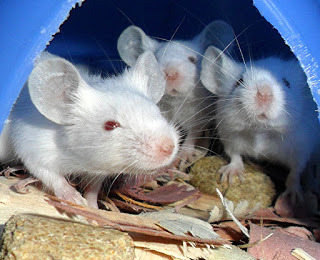 White mice on the bottom of Loch Ness? Surely not… lol (public domain)
White mice on the bottom of Loch Ness? Surely not… lol (public domain)On 20 September 1981, an article penned by George Rosie on the subject of some very intriguing mystery beasts in miniature that had lately been filmed in Loch Ness appeared in no less august a publication than the Sunday Times. During July of that year, Mike Carrie and Jim Hogan had been scouring the loch bottom seeking the 29-year-old wreck of British racing driver John Cobb's jet speedboat, Crusader. (Tragically, Cobb had met his death on the loch after hitting at over 200 mph an unexplained wake - deemed by some to have actually been the LNM - while attempting to break the world water speed record on 29 September 1952 in Crusader, which had then sunk.)
They had been using a specialised underwater television camera that amplified light 2,500 times (essential in the peaty waters of Loch Ness) and was from Carrie's own company, Submersible Television Surveys Ltd. For some time, nothing but barren mud and rocks could be seen, then suddenly some small white life-forms flitted into view, which Carrie and Hogan videoed. According to Carrie:
I can best describe then as giant white tadpoles. They were about two or three inches long, white or pale grey in colour, seemed to have tails and swam just above the bottom.
Hogan, conversely, considered that they more closely resembled "wee white mice" with long tails and legs:
They propelled themselves along the bottom in a jerky way. We knew what size they were because there was an extension to the camera to measure them against.
Greatly intrigued by these highly unexpected and very baffling yet seemingly uncommon mini-monsterlings (they only saw a handful during 3 weeks of filming), Carrie and Hogan submitted their videotape of them to Dr P. Humphrey Greenwood, an ichthyologist at London's Natural History Museum (NHM), for his opinion as to what they may be. Equally fascinated, Dr Greenwood arranged for some computer-enhanced outlines of the mystery beasties to be prepared, which in turn revealed that they seemed to have three pairs of limbs or limb-like protuberances.
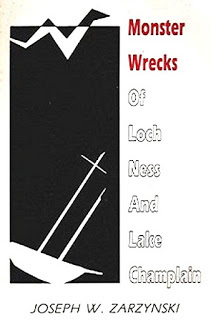 Joseph W. Zarzynski's 1986 book containing a chapter dealing with the 'white mice' of Loch Ness (© Joseph W. Zarzynski - reproduced here on a strictly non-commercial Fair Use basis only)
Joseph W. Zarzynski's 1986 book containing a chapter dealing with the 'white mice' of Loch Ness (© Joseph W. Zarzynski - reproduced here on a strictly non-commercial Fair Use basis only)In a letter dated 18 April 1985 sent to veteran Lake Champlain monster investigator Joseph W. Zarzynski, who had written to him enquiring about this mystifying species, Greenwood stated:
On the subject of that object I am certainly prepared to say that the information on its size, and from what I could determine of its form and locomotion in the videotape, I would suggest that it was a small crustacean, and certainly it was no vertebrate animal that I could identify as being part of the fauna of Loch Ness.
Zarzynski reproduced the above quote in a short chapter devoted to these entities (and also to Tullimonstrum – see more about this enigmatic creature here on ShukerNature) in his book Monster Wrecks from Loch Ness and Lake Champlain (1986).
Additionally, Rose had noted that Greenwood's best guess was that (in Rose's words): "it could be some kind of bottom-dwelling crustacean, hitherto unknown in Loch Ness, similar to some found in other deep-water lakes such as Lake Baikal in Siberia".
 An amphipod (public domain)
An amphipod (public domain)When I read Rose's account in the Sunday Times, I thought straight away of amphipods, which are usually very small, superficially shrimp-like crustaceans represented by both marine and freshwater species. Some of these do have long tails and are often pale in colour, but they sport more than three pairs of legs (though some are only very small and slender, and thus may not have been rendered visible even by the computer-enhancement techniques that the NHM applied to the Carrie-Hogan videotape). So could these loch-bottom mini-monsterlings constitute a new species? Quite possibly - but without a specimen to examine, their taxonomic identity presently remains unresolved.
Interestingly, however, the latter videotape was not the first evidence for the existence of Loch Ness's 'white mice' (the name by which these still-unidentified life-forms are most commonly known nowadays), or at least something like them. As far back as 1972, at around the same time that they obtained their famous underwater 'flipper' photographs in the loch, longstanding Nessie seeker Dr Robert Rines and his team from the Academy of Applied Science (AAS) also filmed what may be the same 'white mouse' species, or possibly a smaller, related version, or even a juvenile version.
A photographic still from that film, which appeared in the AAS's 1972 publication, Underwater Search at Loch Ness, depicted a pale mystery monsterling tha was somewhat bumblebee-like in shape (hence Rines and his team nicknamed such creatures 'bumblebees'). However, it sported a pair of long appendages stretched out horizontally that made it look surprisingly similar to those familiar surface-dwelling freshwater hemipteran insects known as water boatmen (genus Corixa) and backswimmers (genus Notonecta). I am greatly indebted to American lake monster researcher Scott Mardis for kindly sharing with me several additional stills from the AAS's 'bumblebee' film, made available in turn to him by LNM investigator Dick Raynor, which corroborate this mystery creature's morphology as seen in the photograph contained in the AAS's above-noted 1972 publication.
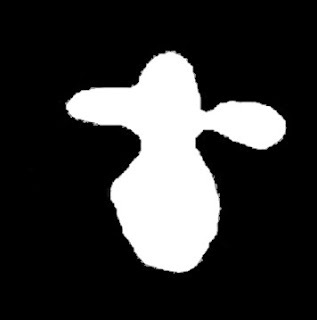 Basic outline of a Loch Ness 'bumblebee' - a sketch based upon the image of one such creature in a photographic still from the 1972 AAS film (© Dr Karl Shuker)
Basic outline of a Loch Ness 'bumblebee' - a sketch based upon the image of one such creature in a photographic still from the 1972 AAS film (© Dr Karl Shuker)Scott has likened the 'bumblebee' form to a veliger (the larva of gastropod molluscs), whereas Canadian cryptozoologist Sebastian Wang has compared it with tiny shelled crustaceans known as ostracods, and Loch Ness veteran Adrian Shine has suggested a cladoceran crustacean (aka water flea) from the genus Bythotrephes. Some mystery beast investigators have even speculated that perhaps it is a larval form of Nessie itself, but unless the latter is an invertebrate, as these 'white mice' and 'bumblebees' must surely be, this notion is untenable.
However, such a huge body mass as possessed by the adult Nessie (judging at least from eyewitness accounts) would surely require an internal skeleton in order to support it and give it shape, which thereby argues against an invertebrate identity for the LNM. This telling point was noted by American college student Jay Cooney in an interesting article dealing with Loch Ness's monsterlings, which he uploaded onto his Bizarre Zoology blog on 30 March 2014. (Unfortunately, however, this particular article later developed image-corruption problems, so Jay subsequently removed it from his blog.)
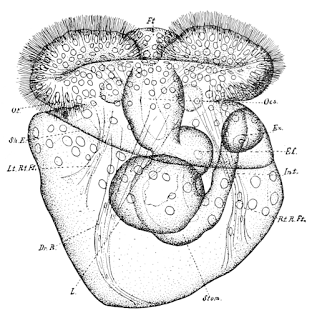 Line diagram of a well-developed veliger (public domain)
Line diagram of a well-developed veliger (public domain)'White mice' and 'bumblebees' are not the only unexplained life forms discovered in Loch Ness. Once again in 1981, but this time in April via a scientific paper written by Dr T.B. Reynoldson and two fellow University College of North Wales zoologists, and published in the Journal of Zoology, the remarkable news was made public that a creature which could legitimately be described as an alien worm had been discovered here too, and in some numbers. More specifically, it was Phagocata woodworthi, a species of North American triclad turbellarian flatworm not native to Europe and never previously recorded from anywhere outside the New World.
Up to 1.2 in long and 0.2 in wide, dark grey, brown, or almost black dorsally, paler ventrally, dorsoventrally flattened, and sporting a truncate head, this out-of-place (o-o-p) invertebrate (o-o-p species are often referred to loosely as alien species) is known to attach its cocoons with limpet-like efficiency to the bottoms of maritime vessels. However, the likelihood that these could remain in situ during an entire transatlantic crossing seems unlikely – plus, few vessels traversing the Caledonian Canal have come from America anyway. So how did this species reach Loch Ness?
 A related species of Phagocata (public domain)
A related species of Phagocata (public domain)With ultimate irony, researchers have concluded that the likeliest sources of these worms are none other than the various monster-hunting vessels that have been transported down through the years from North America directly to the loch, in particular a mini-submarine imported here in 1977.
This ShukerNature blog article is excerpted from my forthcoming book, Here's Nessie! A Monstrous Compendium From Loch Ness – out soon!
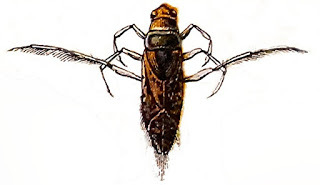 An illustration from 1886 of the common European backswimmer Notonecta glauca (public domain)
An illustration from 1886 of the common European backswimmer Notonecta glauca (public domain)
Published on March 28, 2016 14:54
March 19, 2016
WHATEVER HAPPENED TO THE HUEQUE? SEEKING THE LOST LLAMA OF CHILE
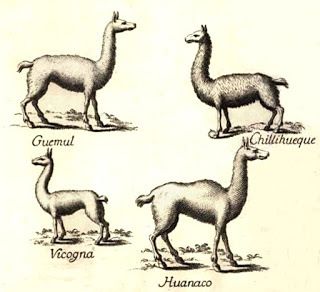 Vidaurre's engraving from 1776 depicting four of the five South American camelids once recognised – llama (top left), hueque aka Chilihueque (top right), vicuna (bottom left), guanaco (bottom right) (public domain)
Vidaurre's engraving from 1776 depicting four of the five South American camelids once recognised – llama (top left), hueque aka Chilihueque (top right), vicuna (bottom left), guanaco (bottom right) (public domain)Llamas are very familiar animals to science and the general public alike. As will now be revealed in this ShukerNature blog article, however, they may well have once shared their native Andean homelands with a highly unfamiliar, all-but-forgotten close relative whose zoological identity and disappearance have remained unexplained for well over 300 years.
ASIAN CAMELS AND SOUTH AMERICAN LLAMAS – THE LAST OF THEIR DYNASTY
Back in prehistoric times, the camelids were a very diverse taxonomic family of artiodactyl (even-toed) ungulates, distributed widely across the globe and represented by small, large, humped, humpless, short, tall, and sometimes very tall forms (such as North America's prairie-inhabiting giraffe camel Aepycamelus, aka Alticamelus).
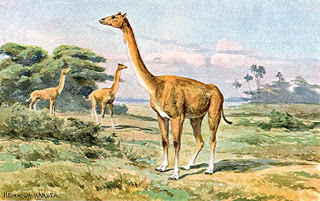 Early restoration of Aepycamelus the giraffe camel by Heinrich Harder in 1920 (public domain)
Early restoration of Aepycamelus the giraffe camel by Heinrich Harder in 1920 (public domain)Today, however, this once-mighty and extremely diverse dynasty is reduced to just six representatives – the two species of humped camel (one-humped dromedary Camelus dromedarius and two-humped Bactrian C. bactrianus) native to Asia (plus feral populations variously established in parts of Europe and Australia); and the four humpless species native to South America. These latter four species are the vicuna, alpaca, llama, and guanaco.
Following the discovery and conquest of South America by the Spanish during the 1500s, its humpless camelids attracted great interest from Western naturalists, with the llama in particular featuring in a number of bestiaries (such as Edward Topsell's famous work The History of Four-Footed Beasts and Serpents, 1658), in which it was generally referred to as the allocamelus.
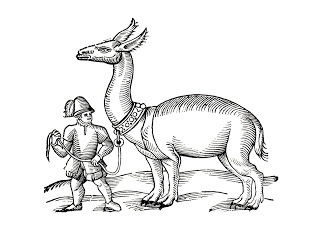 The llama or allocamelus as depicted in Edward Topsell's bestiary The History of Four-Footed Beasts and Serpents (1658) (public domain)
The llama or allocamelus as depicted in Edward Topsell's bestiary The History of Four-Footed Beasts and Serpents (1658) (public domain)It even entered European heraldry, where it was sometimes dubbed the ass-camel, and was duly represented with the head of an ass and the body of a short-legged, convex-backed camel.
The New World's camelid quartet also incited much confusion as to how they were related to one another. For whereas the vicuna and guanaco are wild species, the llama and alpaca are entirely domesticated.
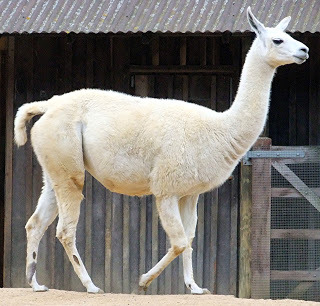 Llama (© Dr Karl Shuker)
Llama (© Dr Karl Shuker)And to make matters even worse, the term 'llama' eventually established itself colloquially as a term not just specific to its own particular single species but also as a general term covering all four South American species.
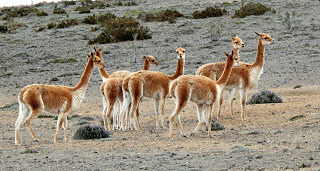 Vicunas (© Haplochromis/Wikipedia
CC BY-SA 3.0 licence
)
Vicunas (© Haplochromis/Wikipedia
CC BY-SA 3.0 licence
)Eventually, the consensus was that the small goat-like vicuna was not just a valid species but one so distinct from the others that it deserved its own genus, and was duly dubbed Vicugna vicugna. The remaining trio were housed together in a second genus, Lama, and were formally christened Lama guanicoe (=huanacos) (the guanaco), L. glama (the llama), and L. pacos (the alpaca), with both the llama and the alpaca being deemed to be domesticated descendants of the guanaco.
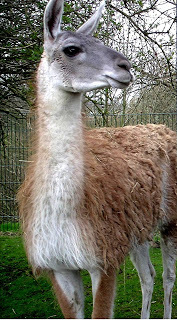 Guanaco (public domain)
Guanaco (public domain)DNA studies published in 2001, however, revealed that the alpaca is in fact most closely related to the vicuna, and is believed to have descended from this latter species, not from the guanaco after all. Consequently, the alpaca is now housed with the vicuna in the genus Vicugna, as Vicugna pacos.
 Alpacas (public domain)
Alpacas (public domain)In addition, there are two non-taxonomic breeds or varieties of alpaca – the rare Suri alpaca, sporting a long, shiny, very soft, slightly-curled fleece, which is very expensive; and the more common Huacaya alpaca, sporting a shorter, fluffier fleece, which is far less expensive.
CAMELID HYBRIDS – THE HUARIZO AND THE CAMA
Yet even though they are now split into separate genera, the alpaca and the llama are sufficiently closely related genetically to yield viable crossbred offspring– a hybrid resulting from interbreeding between a male llama and a female alpaca is known as a huarizo. Much smaller than llamas, it is greatly valued for its very lengthy fleece and gentle disposition, but is usually sterile. Remarkably, moreover, there have even been cases of successful intergeneric hybridisation in captivity between male dromedaries and female llamas, the resulting camel x llama crossbreed being referred to as a cama.
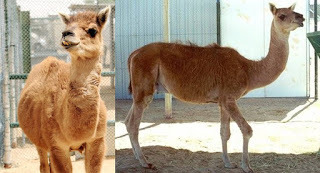 Adult cama (© unknown to me – all information would be welcomed; photographs included on a strictly non-commercial Fair Use basis only)
Adult cama (© unknown to me – all information would be welcomed; photographs included on a strictly non-commercial Fair Use basis only)This surprising feat was first achieved in 1998, via artificial insemination, at the Camel Reproduction Centre in Dubai, the aim being to create an animal with the size, patience, and stamina of a camel but with a fleece at least as good as (if not better than) a llama's. The first cama, a male, born in 1998, was named Rama; a second cama, a female, was born in 2002, and was named Kamilah. In each case, it looked like a large version of its llama mother in overall appearance, and lacked its camel father's hump, but it did possess his small ears and short tail.
A HISTORY OF THE HUEQUE, CHILE'S MISSING MINI-LLAMA
Hybrids notwithstanding, what is not widely known nowadays is that in addition to the vicuna, alpaca, guanaco, and llama, not so very long ago there may also have been a fifth New World camelid species, or at least a well-defined variety of one of the still-existing quartet. Formerly found in Chile, this seemingly-lost and certainly long-forgotten llama was known as the hueque, or the chilihueque in full.
Between the 16thand 17th Centuries, Spanish-speaking travellers who visited the central and south-central valleys of Chile reported the presence in territories owned by the Araucanians (i.e. the Mapuches peoples known here as the Moluche) of a small, distinctive type of llama not seen anywhere else. Moreover, the travellers learnt that its existence here pre-dated the Hispanic conquest, and it may well have been adopted by the Moluche from the Inca culture. This intriguing creature was the hueque, which was generally bred not as a beast of burden (like the llama is in other South American countries) but for its meat and in particular for its fleece, which was extremely soft, luxuriant, and so long that it dragged on the ground as the animal walked.
Having said that, Chilean Jesuit priest and naturalist Father Juan Ignacio Molina noted in his 2-volume magnum opus The Geographical, Natural and Civil History of Chili (1782) that when the Dutch sea captain Admiral Joris van Spilbergen had landed on Chile's small Mocha Island in 1614, he had observed hueques being used to pull small carts by Mapuches living there. Confusingly, however, further on in his book Molina contradicted himself by stating that what van Spilbergen had seen hueques being used for on Mocha Island was pulling ploughs.
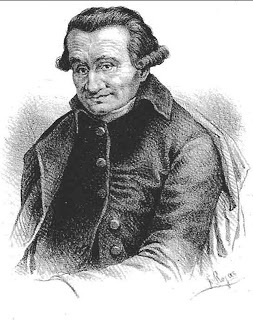 Father Juan Ignacio Molina (public domain)
Father Juan Ignacio Molina (public domain)Writing in 1550 after having conquered southern Chile, the Spanish conquistador Pedro de Valdivia stated that the hueque was very abundant in this region, and that not only were the inhabitants dressed exuberantly in the most elegant woollen clothes but even their houses were stocked full of wool. Also present here was a second camelid, known as the luan, but it was the fleece of the hueque that was always used to manufacture the most prized, sought-after woollen garments. Indeed, the Spaniards were so impressed by this animal's superior fleece that they dubbed it 'the sheep of the land',
The luan was generally identified as the guanaco, but what exactly was the hueque? There was no doubt that it too was some type of llama (using this term in its general sense here), but its precise nature incited much controversy among early naturalists. Two conflicting schools of thought eventually arose. One asserted that it was a local (semi-)domesticated variety of the guanaco distinct from the llama, the other claimed that it was one and the same as the llama and that it had been introduced here from further north, but neither option garnered a significant majority of support. This remains true today.
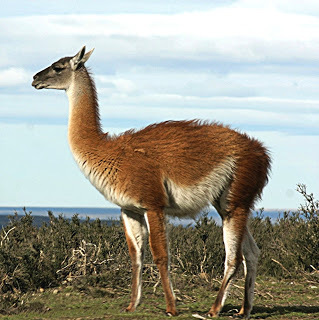 Guanaco photographed in Chile's Torres del Paine National Park (public domain)
Guanaco photographed in Chile's Torres del Paine National Park (public domain)The few illustrations of the hueque that were produced while it still existed generally depicted it as being similar to the llama but somewhat smaller in overall size, with a slightly shorter neck and legs, but sporting a thicker fleece. However, these were based merely upon verbal accounts received from others, rather than upon first-hand observations made by the engravers themselves, so they may not be wholly accurate representations of this lost form. Written accounts of the hueque by Molina and others claimed that it occurred in several different colours – white, brown, black, and grey. Molina also stated that it was approximately 6 ft long, and stood about 4 ft tall.
Perhaps the most natural-looking representation of an alleged hueque, depicted alongside a llama, is the one reproduced below:
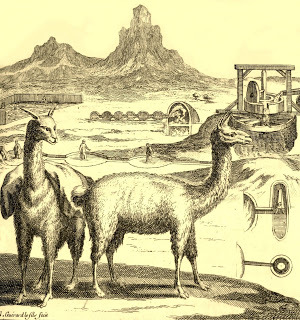 An engraving from a book by Amédée-François Frézier, published in 1716, depicting a llama (on the left) and an alleged hueque (on the right) (public domain)
An engraving from a book by Amédée-François Frézier, published in 1716, depicting a llama (on the left) and an alleged hueque (on the right) (public domain)It appeared as Plate 22 in A Voyage to the South-Sea and Along the Coasts of Chili and Peru in the Years 1712, 1713 and 1714, which was written by French explorer Amédée-François Frézier and published in 1716. Unfortunately, however, whereas the alleged hueque was portrayed in side view, the llama was merely depicted standing face-on, thereby preventing direct morphological comparisons of these two camelid types to be readily made.
WHY DID THE HUEQUE DIE OUT, AND WHAT EXACTLY WAS IT?
The reason why the hueque had vanished by the end of the 17th Century, possibly even earlier, remains unclear. However, its extinction coincided with a major influx of domestic cattle into this region of Chile, brought here from elsewhere for their meat, milk, leather, and as sturdy beasts of burden, as well as European sheep introduced for their wool and meat. Consequently, it has been surmised that not only did they render the hueque superfluous, but these non-native livestock beasts may also have carried with them diseases hitherto unknown here and to which the hueque had no resistance, thus wiping it out.
As for the hueque's identity, that is still unresolved too – or is it? Although, as noted earlier, attempts have been made by various researchers to link the hueque to either the guanaco or the llama, I personally favour a third candidate – the alpaca. So too did English writer and alpaca authority William Walton when describing the alpaca of Peru in his book An Historical and Descriptive Account of the Peruvian Sheep, Called Carneros de la Tierra (1811), though his contribution to the debate concerning the hueque's identity had long been forgotten until I encountered his book recently.
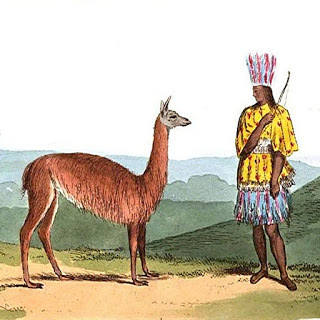 A guanaco with a Peruvian warrior, from Walton's above-cited book (public domain)
A guanaco with a Peruvian warrior, from Walton's above-cited book (public domain)Of the four still-extant South American camelids, it is unquestionably the alpaca that offers the closest correspondence to the hueque. After all, both the hueque and the alpaca were/are bred predominantly for their fleece; both of them yielded/yield wool so profuse and luxuriant that it could/can reach the ground (especially in Suri alpacas); and both of them were/are smaller and more compact than the larger, longer-necked, longer-limbed llama and guanaco.
Could it be, therefore, that a variety of alpaca was either raised within or introduced into central and southern Chile from northern Chile or Peru (where the alpaca occurs naturally), and it was this alpaca form that was in reality the mysterious, now-vanished hueque? If nothing else, it is interesting to note that in an engraving from Gómez de Vidaurre's Compendio della Storia Geografica, Naturale e Civile del Regno del Chile (1776), depicting four South American camelids and opening this present ShukerNature blog article, the hueque is included, but the alpaca is absent. Is this strange omission of such a well known relative in favour of the much more obscure hueque an indication that these two forms were actually one and the same creature?
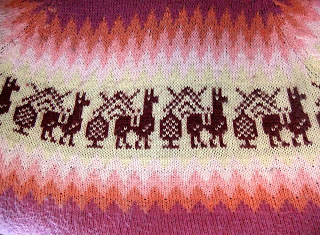 Llama pattern on a Chilean alpaca-wool jumper that was owned by my mother Mary Shuker (© Dr Karl Shuker)
Llama pattern on a Chilean alpaca-wool jumper that was owned by my mother Mary Shuker (© Dr Karl Shuker)After all, if the hueque were actually a separate, distinct species in its own right and was once abundant in southern Chile, plentiful remains of this creature would surely have existed and would have been readily delineated by scientific scrutiny from those of the four known South American camelids. Yet no formal scrutiny and osteological differentiation seems to have been documented, thereby indicating that the hueque was indeed conspecific with one of the pre-existing quartet of species.
Consequently, I conclude that the hueque was most likely to have been a breed or variety of alpaca. Sadly, however, we may well be more than 300 years too late to ever know for sure.
And finally, on a much lighter note, straight from a famous if fictitious animal linguist's circus of exotic creatures, here is the rarest llama-inspired cryptid of all:
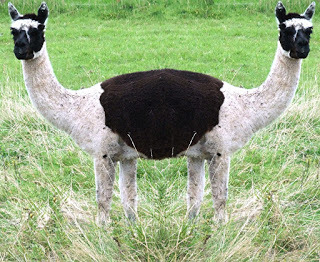 Courtesy of Doctor John Dolittle, my very own pushmi-pullyu (© Dr Karl Shuker)
Courtesy of Doctor John Dolittle, my very own pushmi-pullyu (© Dr Karl Shuker)
Published on March 19, 2016 17:37
March 16, 2016
PROF. HENRY BAUER REVIEWS A MANIFESTATION OF MONSTERS IN THE JOURNAL OF SCIENTIFIC EXPLORATION
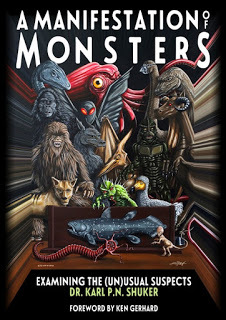
Below is a very positive review of my recent book A Manifestation of Monsters , which has just appeared in the Journal of Scientific Exploration (vol. 30, no. 1, pp. 133-134, 2016), and was penned by Prof. Henry H. Bauer, whose Loch Ness monster book, The Enigma of Loch Ness, remains one of the standard works on this cryptozoological subject.
As can be seen from my book's front cover (the spectacular artwork is by Michael J. Smith), it contains a vast diversity of subjects, including such cryptozoological stalwarts as Nessie, mokele-mbembe, Jersey devil, thylacine, bigfoot, Mongolian death worm, chupacabra, and coelacanths, as well as many much less familiar, much more obscure mystery beasts too that will not be found in any other crypto-book. So be sure to check it out (published by Anomalist Books , it is available in both paperback and Kindle editions on Amazon and elsewhere, and contains a foreword by Ken Gerhard). Here is Prof. Bauer's review:
 Click the above image to enlarge it for reading purposes (©
Journal of Scientific Exploration
/Prof. Henry H. Bauer)
Click the above image to enlarge it for reading purposes (©
Journal of Scientific Exploration
/Prof. Henry H. Bauer)
Published on March 16, 2016 20:57
Karl Shuker's Blog
- Karl Shuker's profile
- 45 followers
Karl Shuker isn't a Goodreads Author
(yet),
but they
do have a blog,
so here are some recent posts imported from
their feed.



